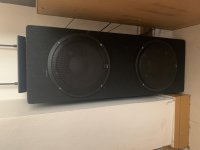EDIT: solved
Hello,
Can anyone tell me if there are going to be issues with this design?
I'm planning to build a ported enclosure with dual subs in it but they will both run on their seperate channels.
Can any problems appear regarding over excursion or distorsion.
The enclosure has 51 liters (with the port and drivers taken into account) and it is tuned to 30,95Hz.
The subs are Dayton Audio SD215A-88 and I'm planning on running them on 60W (RMS is 80W.)
Appreciate the help.
Here's a CAD of the design:



Hello,
Can anyone tell me if there are going to be issues with this design?
I'm planning to build a ported enclosure with dual subs in it but they will both run on their seperate channels.
Can any problems appear regarding over excursion or distorsion.
The enclosure has 51 liters (with the port and drivers taken into account) and it is tuned to 30,95Hz.
The subs are Dayton Audio SD215A-88 and I'm planning on running them on 60W (RMS is 80W.)
Appreciate the help.
Here's a CAD of the design:



Last edited:
I don't suppose you could model the box using double volume and adding the other driver as a passive radiator, to account for the moments that the bass might not be mono?
You could always force the bass to be mono. Have you considered having two subs so you can work with the room?
You could always force the bass to be mono. Have you considered having two subs so you can work with the room?
I did the similar in my passive subwoofer project. But it was sealed type and with separated chambers for each sub. From the CAD you provided, I think it might be better if you would separate the chamber for each sub and give them a port individually.
Hello.
I've forgot to update the thread but that's what I did, I'll be seperating them with 3mm MDF since I kinda already ordered panels custom sized, Should be thick enough, otherwise I'll add support. Thanks anyway tho.

I think if you use the thicker wood panel, preferably the same thickness as the cabinet walls, you may be able to eliminate those bracing rods since the separating panel will be placed on the center of the cabinet walls and that will add mass to the center of them.
I think if you use the thicker wood panel, preferably the same thickness as the cabinet walls, you may be able to eliminate those bracing rods since the separating panel will be placed on the center of the cabinet walls and that will add mass to the center of them.
Good point, I'll still keep the vertical rod since it's meant there for weight support )
- Home
- Loudspeakers
- Multi-Way
- L channel sub and R channel sub same enclosure
